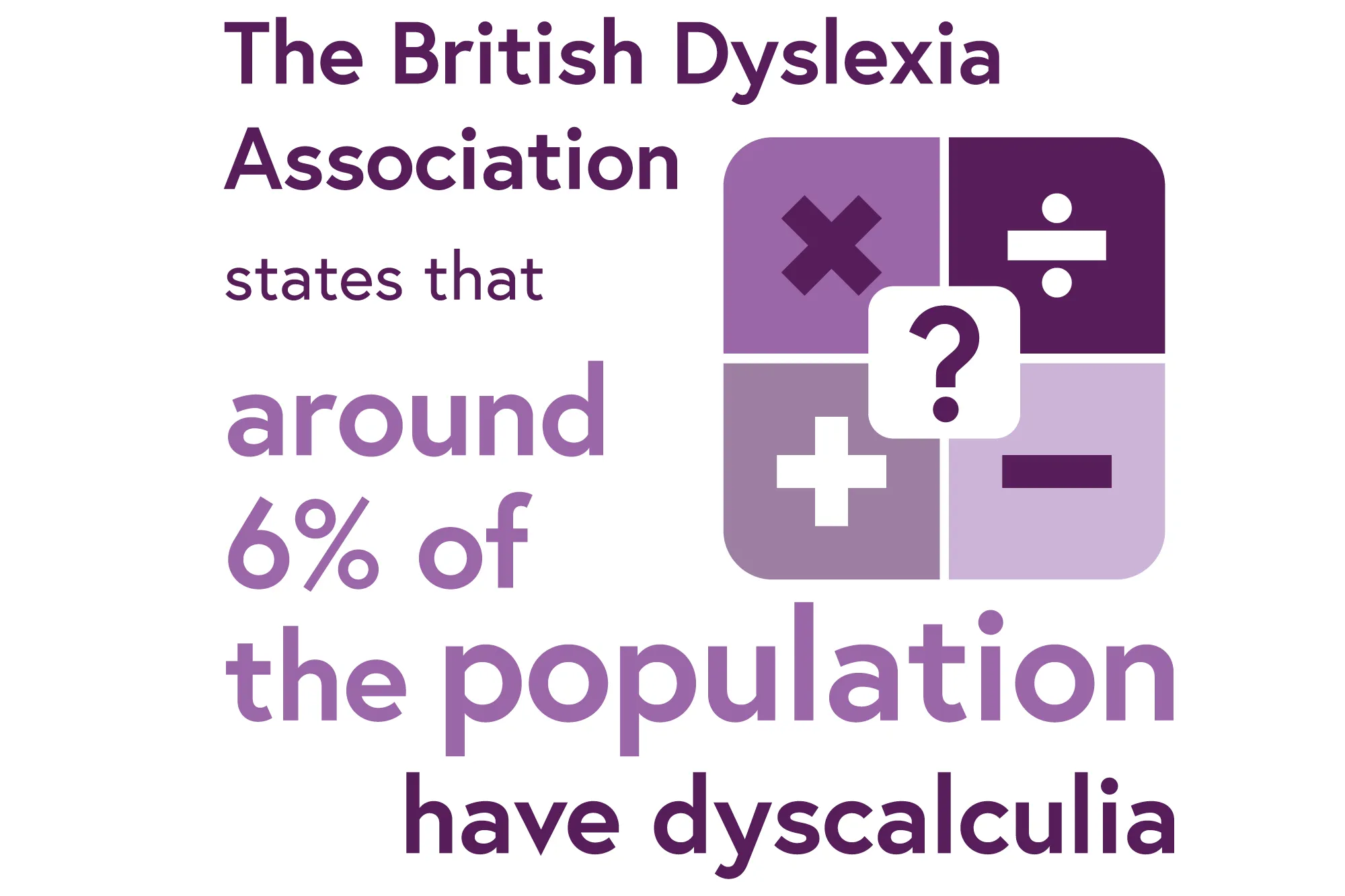Dyscalculia
“Dyscalculia is a specific and persistent difficulty in understanding numbers which can lead to a diverse range of difficulties with mathematics”22
The British Dyslexia Association states that around 6% of the population have dyscalculia and that research into this condition is about 30 years behind research into linked conditions like dyslexia.
As a result, an individual with dyscalculia could be 100 times less likely to receive a diagnosis and be given support.23 For this reason, it’s imperative to educate yourself on the possible signs.
Despite limited existing research, we do know that someone with dyscalculia may exhibit traits like:
- difficulty recognising numbers – it may be harder to identify numbers and how numbers relate to each other (for example, numbers may appear as symbols on a page or screen). As a result, individuals with dyscalculia might
use slower, more visual methods to represent numbers in mathematics, like drawing and counting individual dashes - reduced arithmetic abilities – difficulty in remembering or grasping mathematical formulas, concepts or rules, like addition, subtraction, division and multiplication
- struggles with number patterns – it may be harder to predict numerical patterns and memorise times table sequences. For example, the sequence of 5, 10, 15, 20 may show a clear pattern to those without the condition, but not to an individual with dyscalculia
- difficulty remembering numbers – a tendency to forget numerical codes, passwords or deadlines.
There are many roles within the engineering and technology sector where strong mathematical ability is listed as a requirement, which can present significant barriers for an individual with dyscalculia to enter the industry. However, this doesn’t make it impossible for them to work and thrive within the sector – indeed, with suitable support in place, the experience can be enhanced for the individual and organisation alike.

Following, we list some recognised methods to support an individual with dyscalculia in the workplace.
Supportive ideas for employers and line managers
- Change abstracts to objects – an individual with dyscalculia may see mathematical problems as difficult abstract concepts. Help to bring the problem into the physical space by using objects or graphs to represent numbers; writing problems down in sentence form; or drawing calculations out using images to help them better visualise them.
- Break tasks down – it’s easy for anyone to get overwhelmed by long, complex mathematical problems or concepts. Breaking these down into smaller components will help all colleagues focus and reach accurate results. However, an individual with dyscalculia may need more support and guidance on how to do this effectively.
- Conduct regular reviews – as dyscalculia can affect an individual’s ability to memorise and retain numbers and mathematical concepts, regular refresher sessions can be invaluable in helping to build their internal bank of knowledge. As with anything else, regular practice will lead to improved ability and increased confidence.
- Build a bank – having a physical resource, such as a notebook or guide that outlines the key mathematical processes required to complete the individual’s role, can be a great source of support. Help the individual to build this resource in a way that they understand – perhaps by adding supporting images or sentences.
Supportive ideas for individuals with dyscalculia
- Consider joining a neurodiversity network – a network can be a great place to share your own experiences, concerns or questions, learn from others about theirs and grow your self-confidence. Some organisations have internal neurodiversity networks, but if yours doesn’t, explore options within the wider industry, like our IET Neurodiversity Member Network.
- Display key numbers – keep notes with key numerical information (like your organisation’s phone number and important deadlines) in a visible place around your workspace so that they are easily accessible.
- Explore organisational tools – visual planning software can help you to keep track of your time and projects. Tiimo and Thruday are great options that have been specifically designed to support neurodivergent people. Take a look at the Supportive software page for more options.
- Consider pursuing a diagnosis – if you don’t have a diagnosis, consider if receiving one will be helpful to you. For some, having a diagnosis is validating, offers personal insight and is helpful when requesting support. However, the process can be complex, which is why many people decide not to go down the diagnosis route. Whatever you choose to do, remember that you are entitled to ask for and receive support, regardless of diagnosis.
- Be kind to yourself – remember that although you may need more time to complete numerical aspects of a task, you are not less capable of completing them than your peers. Be patient with yourself and remind yourself of the unique strengths that your neurotype can bring to a workplace, such as strong verbal communication skills, innovative problem solving and creative thinking.
References
22 Dyscalculia - British Dyslexia Association (bdadyslexia.org.uk) (British Dyslexia Foundation, 2023)
23 Dyscalculia - British Dyslexia Association (bdadyslexia.org.uk) (British Dyslexia Foundation, 2023)
We’re upgrading our systems, and this includes changes to our customer and member account log in, MyIET. It’s part of our big picture plan to deliver a great experience for you and our wider engineering community.
Whilst most of our websites remain available for browsing, it will not be possible to log in to purchase products or access services from Thursday, 17 April to Wednesday, 30 April 2025. Our Member Relations team is here to help and for many of our services, including processing payments or orders, we’ll be able to support you over the phone on +44 (0)1438 765678 or email via membership@theiet.org.
We apologise for any inconvenience this may cause and thank you for your understanding.
For further information related to specific products and services, please visit our FAQs webpage.
